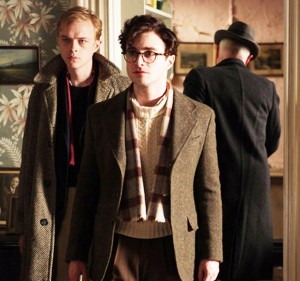Kill Your Darlings recalls beat movement poets
Imagine Daniel Radcliffe playing a shy young man from a broken home: His hair is long and shaggy, glasses swallow his face and he wears a brooding expression as he pursues an education on a beautiful gothic campus. At least on the surface, the parallels between Radcliffe’s depiction of Allen Ginsberg in John Krokidas’ big screen debut Kill Your Darlings and Radcliffe’s most well-known character, Harry Potter, are hard to ignore. Yet, somehow, Radcliffe seamlessly steps into Ginsberg’s shoes, and once the theater goes dark, any Potter comparisons are immediately forgotten in this intense and culturally significant new film.

Potter no longer · Daniel Radcliffe (right) stars as Allen Ginsberg in Kill Your Darlings, a film about the early stages of the beat movement. – Photo courtesy of Sony Pictures Classics
At home in Paterson, N.J., quiet Ginsberg must deal with a mentally unstable mother and an apathetic father. His timidity accompanies him to Columbia University, where he is struck by the university’s stuffiness, as well as its radical thinkers — embodied by the subversive and charming Lucien Carr (Dane DeHaan). The two explore New York City’s bohemian scene, where Ginsberg meets William Borroughs (Ben Foster), Jack Kerouac (Jack Huston) and David Kammerer (Michael C. Hall), all of whom are Carr’s friends.
The group establishes a would-be literary movement called “The New Vision,” which rejects bourgeois conventions by focusing on uninhibited self expression, and is in many ways an antecedent to the beat movement. The work of W.B. Yeats, whose book, A Vision, inspired the group’s name, provides a backdrop to their collective quest of self discovery. The group galivants through the city, partying, listening to jazz and generally comporting themselves in the same frenzied manner Kerouac describes in his novels without actually writing anything.
Portraying the beat lifestyle is so difficult because it’s virtually impossible to depict its spontaneity and groundlessness within the structure of a film. Krokidas, however, valiantly strives to portray the group’s quest for uninhibited expression, particularly in his use of innovative cinematic techniques to capture their Benzedrine-fueled exploits. Fast motion shots, as well as an incredible scene in which everyone in a jazz club freezes in time, allow the viewer to experience their trips.
Krokidas makes it clear from the outset that World War II and its cultural ramifications are essential ingredients to the characters’ alienation. At one point Carr muses, “We’re sending millions to Europe to fight the fascists, but they’re all here.” The film, however, does not portray their rejection of convention in a one-sided light. In fact, Carr and Ginsberg can seem just as out of touch as the adults they resent. Their highly traditional professor helps contextualize their rebellion by asking them, “You want life? You want the world on fire? The war awaits.”
Sexuality, particularly in such a repressive cultural climate, also contributes to the group’s rejection of the status quo. At first, Ginsberg is very careful to hide his homosexuality. When Lucien reveals that Kammerer is “a f-cking queer,” Ginsberg responds, “Let’s get rid of him.” This eerie and self-hating foreshadowing makes the terrifying struggle of a young gay man in the 1940s come alive. Contemporary popular media is full of sexuality complicating friendships. Yet this film is boundary-breaking in that these difficult-to-define relationships are among men. In fact, all potential female love interests in the film function as stepping stones toward a larger goal; they are not the goals themselves, even for the characters interested in women.
Krokidas emphasizes that this is not just a film about the gay experience. It is a film about a group of young men -— some of whom are gay — struggling to grow and develop in an intellectually and sexually oppressive environment. This matter-of-fact perspective on homosexuality is indicative of its acceptance in mainstream culture. Not every film about LGBT people has to be a message movie.
As in its portrayal of homosexuality, the film also distances itself from over-the-top beat archetypes, largely thanks to its fabulous acting. The characters collectively embody the fact that the term beat refers to a general state of non-conformity, rather than some sort of monolithic movement. The only character that sometimes falls into that trap is Kerouac, who is portrayed by the British actor Jack Huston of Boardwalk Empire fame. Huston can’t quite capture the icon’s all-American gravitas, or his internal struggle between freedom and guilt. In Huston’s defense, there’s a reason there has never been a successful film adaptation of Kerouac’s novels.
The plot of the film exposes the viewer to the sort of uncensored content Ginsberg and his friends wanted to bring into the open. The most heightened moment of the film — a montage of three scenes — embodies this uncensored spirit. Kerouac and his girlfriend Edie have just made up and are the picture of domestic bliss. The real turmoil of their relationship is illustrated by the juxtaposition of Carr stabbing Krammerer. The third scene poignantly depicts Ginsberg losing his virginity. The rhythm of his lover’s passion matches that of Carr’s knife.
Kill Your Darlings’ climax lives up to the film’s sophisticated take on the beat lifestyle. The film strives to make this group of extraordinary young men and their era emotionally accessible to modern viewers. It succeeds handily, thanks to both the actors’ (Radcliffe in particular) and filmmakers’ willingness to stray from convention — just like the beats did.
Follow us on Twitter @dailytrojan
